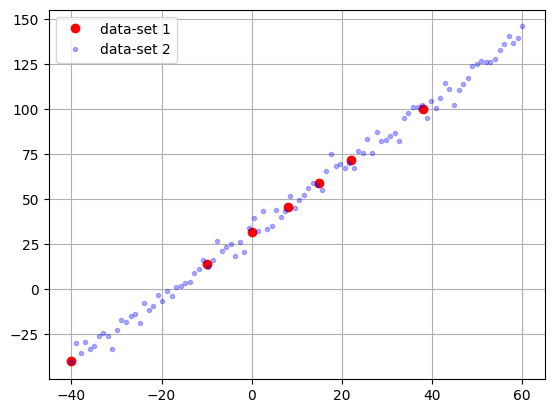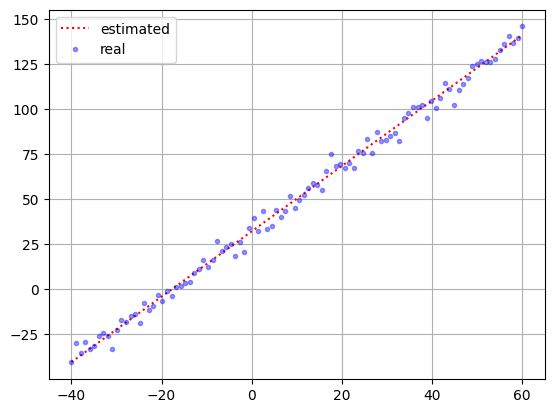You cannot select more than 25 topics
Topics must start with a letter or number, can include dashes ('-') and can be up to 35 characters long.
|
|
9 months ago | |
|---|---|---|
| Readme_files | 9 months ago | |
| .gitignore | 9 months ago | |
| Readme.md | 9 months ago | |
| main.ipynb | 9 months ago | |
Readme.md
#!pip3 install tensorflow
import tensorflow as tf
import numpy as np
import matplotlib.pyplot as plt
# data for training the ann mode
# option 1:
celsius = np.array([-40, -10, 0, 8, 15, 22, 38], dtype=float)
fahrenheit = np.array([-40, 14, 32, 46, 59, 72, 100], dtype=float)
# option 2: (X°C x 9/5) + 32 = 41 °F
points = 100
np.random.seed(99)
dataIn = np.linspace (-40,60, points)
target = dataIn*9/5 + 32 +4*np.random.randn(points)
plt.plot(celsius, fahrenheit, 'or', label='data-set 1')
plt.plot(dataIn, target, '.b', alpha=0.3, label='data-set 2')
plt.legend()
plt.grid()
plt.show()
from tensorflow.keras.models import Sequential # ANN type
from tensorflow.keras.layers import Dense, Input # All nodes connected
# NN definition
hn=2
model = Sequential()
model.add(Input(shape=(1,), name='input'))
model.add(Dense(hn, activation='linear', name='hidden'))
model.add(Dense(1, activation='linear', name='output'))
model.summary()
Model: "sequential_1"
┏━━━━━━━━━━━━━━━━━━━━━━━━━━━━━━━━━┳━━━━━━━━━━━━━━━━━━━━━━━━┳━━━━━━━━━━━━━━━┓ ┃ Layer (type) ┃ Output Shape ┃ Param # ┃ ┡━━━━━━━━━━━━━━━━━━━━━━━━━━━━━━━━━╇━━━━━━━━━━━━━━━━━━━━━━━━╇━━━━━━━━━━━━━━━┩ │ hidden (Dense) │ (None, 2) │ 4 │ ├─────────────────────────────────┼────────────────────────┼───────────────┤ │ output (Dense) │ (None, 1) │ 3 │ └─────────────────────────────────┴────────────────────────┴───────────────┘
Total params: 7 (28.00 B)
Trainable params: 7 (28.00 B)
Non-trainable params: 0 (0.00 B)
### veri important note implement a python code
# to show the ANN model connection using ascii
from tensorflow.keras.optimizers import Adam
#hyper parameters
epoch = 500
lr = 0.01
hn = 2 # hidden nodes
tf.random.set_seed(42) # For TensorFlow
model.compile(optimizer=Adam(lr), loss='mean_squared_error')
print("Starting training ...")
historial = model.fit(dataIn, target, epochs=epoch, verbose=False,)
print("Model trainned!")
Starting training ...
Model trainned!
predict = model.predict(dataIn)
plt.plot(dataIn, predict, ':r', label='estimated')
plt.plot(dataIn,target, '.b', label='real', alpha=0.4)
plt.legend()
plt.grid()
plt.show()
[1m4/4[0m [32m━━━━━━━━━━━━━━━━━━━━[0m[37m[0m [1m0s[0m 4ms/step
# Get weights
for layer in model.layers:
weights = layer.get_weights()
print(f"Layer: {layer.name}")
print(f" Weights (Kernel): {weights[0].shape} \n{weights[0]}")
print(f" Biases: {weights[1].shape} \n{weights[1]}")
Layer: hidden
Weights (Kernel): (1, 2)
[[-0.27738443 0.7908125 ]]
Biases: (2,)
[-8.219968 6.714554]
Layer: output
Weights (Kernel): (2, 1)
[[-1.9934888]
[ 1.5958738]]
Biases: (1,)
[5.1361823]
Testing the model
inTest = np.array([100])
model.predict(inTest)
[1m1/1[0m [32m━━━━━━━━━━━━━━━━━━━━[0m[37m[0m [1m0s[0m 87ms/step
array([[213.73816]], dtype=float32)
# Do the Maths:
inTest = np.array(inTest)
whi = np.array([[-0.27738443, 0.7908125 ]])
bh = np.array([-8.219968, 6.714554])
Oh = np.dot(inTest,whi)+bh
who = np.array([[-1.9934888],[ 1.5958738]])
bo = np.array([5.1361823])
Oo = np.dot(Oh,who)+bo
Oo
array([213.73814765])
def generate_ascii_ann(model):
ascii_diagram = "\nArtificial Neural Network Architecture:\n"
for i, layer in enumerate(model.layers):
weights = layer.get_weights()
# Determine layer type and number of neurons
if isinstance(layer, Dense):
input_dim = weights[0].shape[0] # Number of inputs
output_dim = weights[0].shape[1] # Number of neurons
ascii_diagram += f"\nLayer {i+1}: {layer.name} ({layer.__class__.__name__})\n"
ascii_diagram += f" Inputs: {input_dim}, Neurons: {output_dim}\n"
ascii_diagram += f" Weights Shape: {weights[0].shape}\n"
if len(weights) > 1: # If bias exists
ascii_diagram += f" Biases Shape: {weights[1].shape}\n"
# ASCII representation of neurons
ascii_diagram += " " + " o " * output_dim + " <- Output Neurons\n"
ascii_diagram += " | " * output_dim + "\n"
ascii_diagram += " " + " | " * input_dim + " <- Inputs\n"
return ascii_diagram
# Generate and print the ASCII diagram
ascii_ann = generate_ascii_ann(model)
print(ascii_ann)
Artificial Neural Network Architecture:
Layer 1: hidden (Dense)
Inputs: 1, Neurons: 2
Weights Shape: (1, 2)
Biases Shape: (2,)
o o <- Output Neurons
| |
| <- Inputs
Layer 2: output (Dense)
Inputs: 2, Neurons: 1
Weights Shape: (2, 1)
Biases Shape: (1,)
o <- Output Neurons
|
| | <- Inputs
graph LR
I1((I_1)) --> H1((H_1)) & H2((H_1))
H1 & H2 --> O1((O_1)) & O2((O_2))

